Global Energy - December Commentary
This is a marketing communication. Please refer to the prospectus, supplement and KID/KIID for the Funds before making any final investment decisions. The value of this investment can fall as well as rise as a result of market and currency fluctuations. You may not get back the amount you invested.
Past performance does not predict future returns.
Oil demand and supply outlook for 2026
After a year of strong supply growth in 2025, we look ahead in this month’s commentary to prospects for oil demand and supply in 2026 and beyond. Oil demand continues to grow reasonably well, led by consumption in South-East Asia. Any peak in demand looks to be pushed back into the early 2030s at the earliest. Brazil, Guyana, Canada, and the US each contribute to another year of non-OPEC supply growth in 2026, leaving OPEC needing to remain disciplined in its own production to achieve market balance.
Oil demand
Looking into 2026, the IEA estimates demand growth of 0.8m b/day (based on GDP growth of 3.1%) with the non-OECD up by 0.9m b/day and the OECD down by 0.1m b/day. This would be in line with the long-term trend: emerging-market GDP growth driving demand higher, offset to a small extent by OECD oil demand in a very steady decline. Oil demand in 2026 of 104.7m b/day will be around 4m b/day above the pre-COVID 2019 peak. Unlike previous years, however, China is not expected to be a dominant driver of demand growth. At only 0.2m b/day, China’s demand growth is in line with that expected from India, Other Asia and the Middle East.
Global demand growth in 2026 is likely to be concentrated in petrochemical feedstocks (naphtha, LPG, and ethane). This trend is supported by China’s commissioning of major new ethane and LPG processing facilities across its coastal hubs, complemented by petrochemical expansion in other parts of South-East Asia and the Middle East. In contrast, incremental gasoline consumption remains close to zero in 2026, as gains in India, Africa and parts of South-East Asia are offset by declines in Europe, Korea and some parts of China.
Regionally, India, Africa and the Middle East contribute meaningfully to global oil demand growth. India’s growth is fueled primarily by gasoline and diesel, driven by growing vehicle ownership and expanding freight activity. Growth is Africa is underpinned by population growth, urbanisation and low car and truck ownership rates. And in the Middle East, growth comes from LPG, jet fuel and diesel demand associated with logistics and large-scale construction projects.
The “affordability” of oil is a driver of demand, and globally, we believe that oil remains a cheap commodity. Based on a Brent oil price of around $75/bl in 2026, we calculate that the world would spend around 2.4% of GDP on oil, below the 30-year average of around 3.0% and well below the 4.1% seen in 2007 when oil also averaged around $75/bl. We believe that oil would need to increase to around $150/bl, reflecting nearly 5% of world GDP in 2026, if it were to have a noticeable negative impact on the global economy.
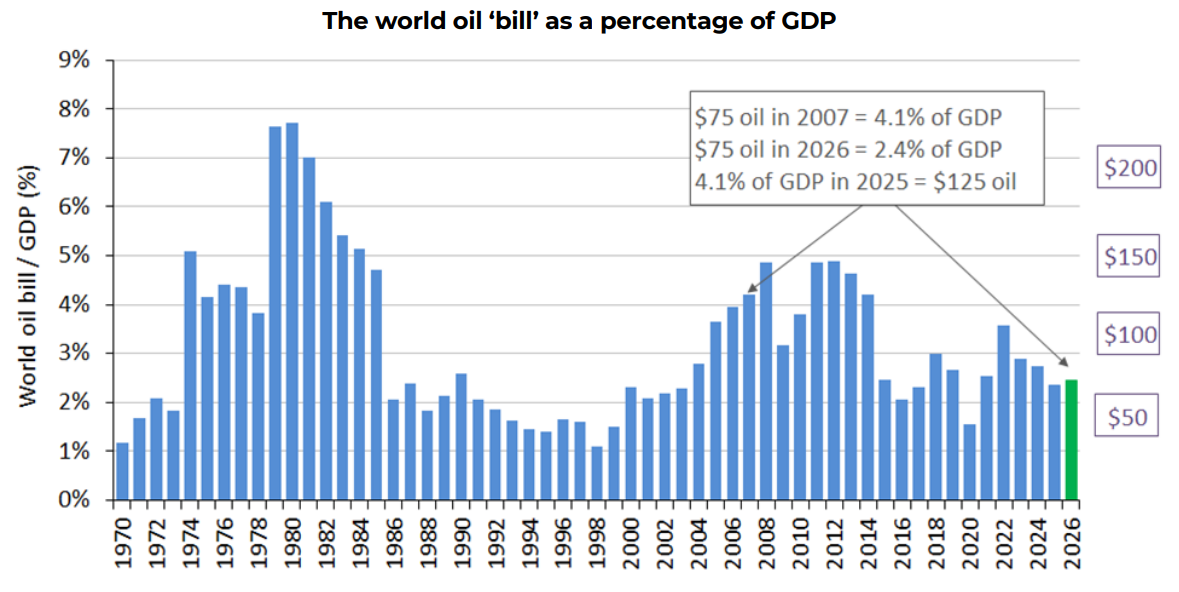
Source: IEA; Bloomberg; Guinness Global Investors, December 2025
Another way to think about the relative value of oil is to compare its price to that of another real asset, gold. Over the last 55 years, one ounce of gold has bought, on average, just under 18 barrels of oil. Oil became comparatively expensive in the early 2000s, when this ratio fell to around 10 barrels of oil. Following the COVID volatility of the early 2020s, we have seen a sharp increase in the gold price that has not been matched by oil. As a result, one ounce of gold now buys around 67 barrels of oil, the most significant relative value of oil versus gold over this period. Should the relationship return to the long-run average, and the gold price stayed flat, it would imply an oil price today of around $240/bl.
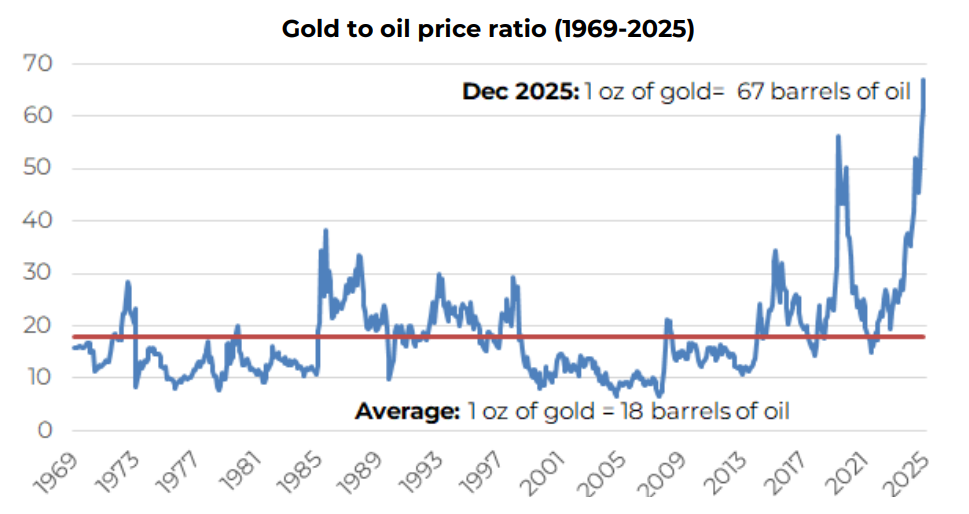
Source: IEA; Bloomberg; Guinness Global Investors, December 2025
Looking beyond 2025, when will oil demand peak? Our assumptions for EV adoption see around 4-5m b/day of oil demand displaced globally by 2030, rising to 12-13m b/day by 2040. However, our analysis of other demand sources (for example, aviation and the continued expansion of the petrochemical industry) indicates continued demand growth. Taken together, the most likely scenario for peak oil demand is sometime in the early 2030s, reaching a peak of 107-110m b/day, with Asia Pacific providing the majority of total demand growth until then, supported by Africa and the Middle East. And despite rapid EV adoption around the world in the 2030s, we expect oil demand to plateau for a few years rather than decline sharply. We expect oil demand in 2040 to remain around 100m b/day, consistent with 2018/2019 levels.
Oil supply
After a year of strong production growth in 2025 (+2.6m b/day), the world’s oil supply growth is likely to slow to around 1.1m b/day in 2026, led by Brazil, Guyana, Canada and the US. Notably, 2026 could be the first year in which non-OPEC supply surpasses that of OPEC+ supply. And with non-OPEC supply continuing to grow by around 1m b/day (similar to the growth in global oil demand we expect), the onus will remain on the OPEC+ group to keep their production growth in check to balance the market. As ever, there are wildcards in the supply market, with the focus currently on Iran, Russia and Venezuela.
Non-OPEC+ supply
For much of the last decade, growth in the US shale industry had kept global oil markets well supplied. Latest data from the Energy Information Administration (EIA) for September 2025 confirmed production of 11.4m b/day, well surpassing the pre-COVID peak (November 2019) of 10.5m b/day and implying around 0.25m b/day growth on average from 2024 levels.
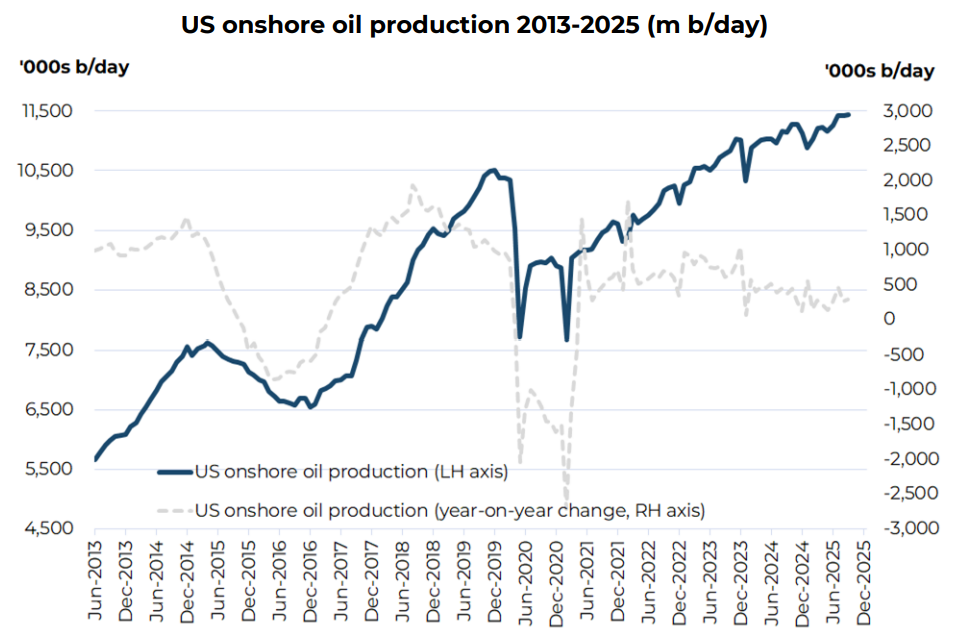
Source: EIA; Bloomberg; Guinness Global Investors, December 2025
The previous cycle of production growth, between 2016 and 2019, was achieved thanks to near limitless funding from equity and debt markets, combined with a producer mentality that favoured growth over returns. By contrast, the rebound in US shale oil production growth since 2020 has been more modest due to lower drilling activity (driven by greater capital discipline from E&P companies, inflation, and higher interest rates) and, in the last couple of years, flat drilling and fracing activity levels.
At the start of 2025, President Trump declared a “national energy emergency” and encouraged US oil and gas producers to “drill, baby, drill” as a means of improving production. The reality, however, has been next to no response from US oil producers, with little getting in the way of the industry’s focus on free cash flow over growth. Historically, the politics of the US President have not impacted US oil production levels.
The US shale system continues to become more efficient, drilling longer lateral wells, automating completions, and improving well spacing to boost productivity. That said, the US oil drilling rig count has declined from 475 at the start of the year to 409 rigs, a drop that likely means very small shale oil growth (say 0.1-0.2m b/day) in 2026 at best, or possibly flat production.
Ultimately, US supply will continue to be closely watched by OPEC, but it poses much less of an oversupply risk than it did five or ten years ago.
Away from US shale, after a sustained period of underinvestment, capital spending has picked up again in the non-OPEC world. In particular, investment is being directed towards deepwater projects in Brazil and Guyana. Indeed, Brazil is likely to be the largest source of oil supply growth in 2026, underpinned by a queue of floating production units that are in the final stages of commissioning. In total, eight relatively new projects will contribute to Brazil’s supply expansion in 2026. The growth will be moderated by modest declines at mature reservoirs in the country, but the net increase should still be around 0.4m b/day. It is a similar story in Guyana. The Errea Wittu floating production unit, which has a capacity of 0.25m b/day, is currently in Singapore for commissioning and due for delivery in Guyana in mid-2026. This will help drive net supply growth in the country of around 0.2m b/day.
In Canada, the commissioning of the Trans Mountain Expansion pipeline in 2024 is supporting steady increases in production. The Canadian oil system is dominated by oil sands operations, where natural decline rates are low and incremental volumes are driven by incremental improvements rather than new megaprojects. Growth in 2026 is expected to be 0.1-0.2m b/day.
Offsetting the growth, various oil ‘champions’ of the past now struggle with mature and declining production. For example, Mexico reported an oil supply in October 2025 of 1.4m b/day, down by around 0.25m b/day in 2023. Mexico’s oil production has declined in recent years mainly due to accelerating depletion at its giant mature offshore fields, especially the Ku-Maloob-Zaap complex. National oil company Pemex’s high debt burden and reduced upstream spending have constrained drilling, maintenance and new project development, accelerating natural decline rates.
OPEC+ oil supply
One of the key overhangs in the oil market at the start of 2025 was the elevated level of OPEC's spare production capacity. Depending on the view of capacity effectiveness in certain countries, spare capacity in early 2025 ranged from 4.5% to 5.5% of global oil demand, versus the long-term norm of around 3-3.5%. With OPEC increasing its quotas in 2025 by around 2.5m b/day, spare capacity has fallen to around 3%, in line with long-term averages.
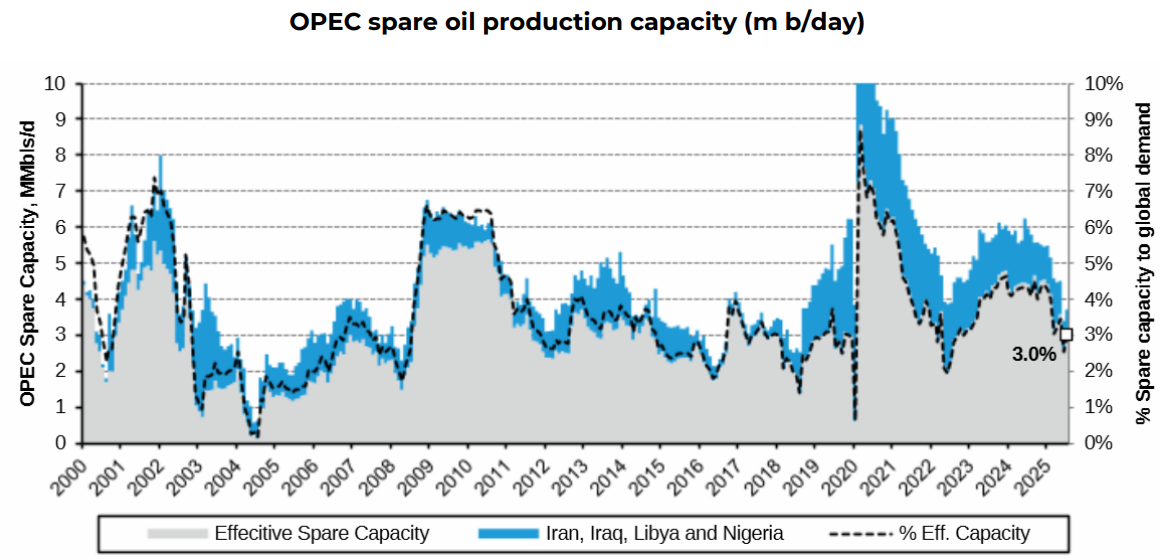
Source: Bernstein, December 2025
OPEC+, led by Saudi Arabia, will continue managing the oil market in 2026, aiming to defend a reasonable price through supply discipline. The 30 November 2025 OPEC+ meeting confirmed this intention, when the group announced the following:
- No production quota increases in Q1 2026
- The possibility of reversing 1.6m b/day of voluntary quota cuts that have been in place since mid-2023, but only if the oil market allows.
- Continued ‘compensation plans’ from members of the group (Iraq, UAE, Kazakhstan and Oman) who have been overproducing versus quotas
OPEC’s actions in recent years have demonstrated a commitment to delivering a reasonable oil price to support their own economies and to incentivise investment in long-term projects. Saudi’s actions at the head of OPEC have been designed to achieve an oil price that, to some extent, closes their fiscal deficit (c.$92/bl is needed to close the gap fully), whilst not spiking the oil price too high and over-stimulating non-OPEC supply. We expect continued flexibility from OPEC+, particularly Saudi, in 2026 to adjust production and put a ‘soft’ floor under oil prices should oil demand falter.
Overall, we believe that Saudi’s long-term objective remains to maintain a ‘good’ oil price, as close to their fiscal breakeven of around $92/bl as possible, without overstimulating non-OPEC supply.
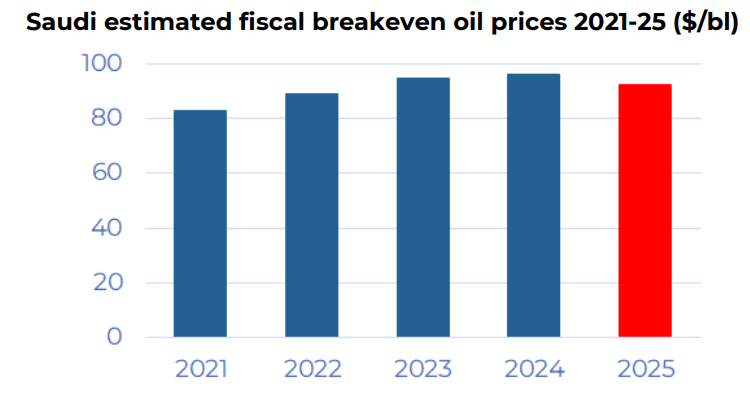
Sources: IMF; DNB, Guinness Global Investors, December 2025
*’Breakeven oil price’ is defined as the oil price needed by Saudi Arabia to balance its fiscal budget.
Similar to 2025, the key ‘wildcards’ in the OPEC+ group are Russia, Venezuela and Iran. The actions of President Trump will impact supply from these areas in 2025, more than likely reducing potential supply growth in 2025 and allowing OPEC+ some room to return additional volumes to the market:
- Russian production is currently around 9.5m b/day, and has risen a little in recent months, aligning with volumes permitted under the OPEC+ framework. This compares to Russia’s estimated oil supply capacity of 9.7m b/day. In 2026, should the Russia/Ukraine war continue, we see downside to Russian oil and refined product exports, as US sanctions on Rosneft and Lukoil, plus the buyers of Russian oil, start to bite. Against this, if we were to see a ceasefire agreed, we expect disruption to Russian exports (we estimate at around 0.5m b/day) to fade away.
- Oil exports from Iran, currently around 1.5m b/day (flat year-on-year), flow almost exclusively to China, often via ship-to-ship transfers and blending hubs (e.g. Malaysia) to mask their origin. During Autumn 2025, there has been a significant buildup of ‘oil on water’, meaning oil in transit or storage offshore. According to Kpler, much of this oil comes from Iran, and is struggling to find a home as China’s appetite becomes more muted. Prospects for Iranian oil exports in 2026 depend on how hawkish the US administration is prepared to be.
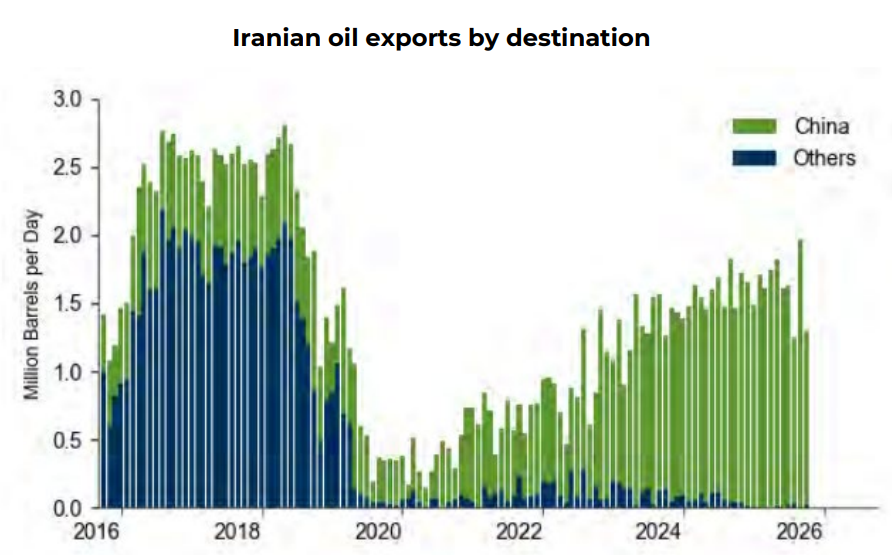
Source: DNB, December 2025
- Venezuela has seen escalating geopolitical pressure in recent months, reviving the scenario of a political transition in the country. In a post-Maduro scenario, there may be a production shock (the 2002/03 PDVSA strike caused a temporary fall of around 50%). Longer-term, however, we could see production rebound from current levels of around 0.9-1.0m b/day to around 1.2m b/day.
To read the full report, click the link below.
The value of this investment can fall as well as rise as a result of market and currency fluctuations. You may not get back the amount you invested.
The information provided on this page is for informational purposes only. While we believe it to be reliable, it may be inaccurate or incomplete. Any opinions stated are honestly held at the time of publication, but are not guaranteed and should therefore not be relied upon. This content should not be relied upon as financial advice or a recommendation to invest in the Funds or to buy or sell individual securities, nor does it constitute an offer for sale. Full details on Ongoing Charges Figures (OCFs) for all share classes are available here.
The Guinness Global Energy Funds invest in listed equities of companies engaged in the exploration, production and distribution of oil, gas and other energy sources. We believe that over the next twenty years the combined effects of population growth, developing world industrialisation and diminishing fossil fuel supplies will force energy prices higher and generate growing profits for energy companies. The Funds are actively managed and use the MSCI World Energy Index as a comparator benchmark only.
For the avoidance of doubt, if you decide to invest, you will be buying units/shares in the Fund and will not be investing directly in the underlying assets of the Fund
Documentation
The documentation needed to make an investment, including the Prospectus, the Key Information Document (KID) / Key Investor Information Document (KIID) and the Application Form, is available from the website www.guinnessgi.com, or free of charge from:
- the Manager: Waystone Management Company (IE) Limited (Waystone IE), 2nd Floor 35 Shelbourne Road, Ballsbridge, Dublin DO4 A4E0; or,
- the Promoter and Investment Manager: Guinness Asset Management Ltd, 18 Smith Square, London SW1P 3HZ.
Waystone IE is a company incorporated under the laws of Ireland having its registered office at 35 Shelbourne Rd, Ballsbridge, Dublin, D04 A4E0 Ireland, which is authorised by the Central Bank of Ireland, has appointed Guinness Asset Management Ltd as Investment Manager to this fund, and as Manager has the right to terminate the arrangements made for the marketing of funds in accordance with the UCITS Directive.
Investor Rights
A summary of investor rights in English, including collective redress mechanisms, is available here: https://www.waystone.com/waystone-policies/
Residency
In countries where the Funds are not registered for sale or in any other circumstances where their distribution is not authorised or is unlawful, the Funds should not be distributed to resident Retail Clients. NOTE: THIS INVESTMENT IS NOT FOR SALE TO U.S. PERSONS.
Structure & Regulation
The Fund is a sub-fund of Guinness Asset Management Funds PLC, an open-ended umbrella-type investment company, incorporated in Ireland and authorised and supervised by the Central Bank of Ireland, which operates under EU legislation. The Fund has been approved by the Financial Conduct Authority for sale in the UK. If you are in any doubt about the suitability of investing in the Fund, please consult your investment or other professional adviser.
WS Guinness Global Energy Fund
Documentation
The documentation needed to make an investment, including the Prospectus, the Key Investor Information Document (KIID) and the Application Form, is available in English from https://www.waystone.com/our-funds/waystone-fund-services-uk-limited/ or free of charge from:-
Waystone Management (UK) Limited, PO Box 389, Darlington DL1 9UF.
General enquiries: 0345 922 0044
E-Mail: iwtas-investorservices@waystone.com
Waystone Management (UK) Limited is authorised and regulated by the Financial Conduct Authority.
Residency
In countries where the Fund is not registered for sale or in any other circumstances where its distribution is not authorised or is unlawful, the Fund should not be distributed to resident Retail Clients.
Structure & regulation
The Fund is an Authorised Unit Trust authorised by the Financial Conduct Authority.
This Fund is registered for distribution to the public in the UK but not in any other jurisdiction. In other countries or in circumstances where its distribution is not authorised or is unlawful, the Fund should not be distributed to resident Retail Clients.




